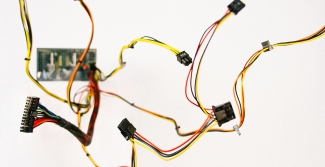5 high-tech contact lenses that could change the world
Photo by Randall Bruder on Unsplash
As wearable vision correction goes, it doesn’t get more low-key than contact lenses. The remarkably thin lenses are invisible to most, but they work wonders.
The appeal of this discreet design has led to many high-tech inventions, with a variety of innovative features. Here are five contact lenses that might just have the potential to change the world.
5. Dissolving ‘Nanowafer’ contact lenses
Delivering medicine to the eye can be tricky when it’s needed regularly. The eye’s reflexes tend to wipe or wash away most medicines, massively reducing their effectiveness. Using eye drops is particularly difficult (and messy) and attempting to give eye drops to children is something no parent deserves to endure.
Researchers at the Baylor College of Medicine in Dallas think they’ve found a better way. They’ve developed an ultra-thin contact lens, called a ‘Nanowafer,’ that can deliver drugs to the eye over a long period of time.
The Nanowafers slowly dissolve, releasing tiny amounts of drugs into the eye. The rate at which the lens dissolves can be set between a few hours and several days. This helps to offer a far more reliable, steady dose than regular eye drops.
Thanks to the sleek, highly practical design, it’s easy to see how the concept could have a huge impact on eye-administered medicine.
4. Telescopic contact lenses

Most people have at one time wished to have superpowers (or still do). A team at the Swiss Federal Institute of Technology believe this dream could soon become a reality.
The team has created a prototype lens that enables wearers to make objects appear 2.8 times larger than reality. To enable this ‘superpower,’ the wearer just needs to wink with one eye, causing their vision to ‘zoom’ in, much like a camera.
The lenses contain tiny aluminium mirrors, which cause the light to bounce in a specific way. A polarising filter directs light towards or away from the mirrors, depending on which eye the wearer winks with.
The lenses could help those with macular degeneration and offer a discreet method of magnification for the military. Either way, we can’t wait until the day superpowers are available for everyone!

3. 3D-printed contact lenses

Photo by Rob Wingate on Unsplash
When it comes to creating something that’s worn on your eye, precision and care is paramount. Contact lenses use exact specifications and are made using delicate materials. They’re certainly not something that you could make in your own home – not yet, at least.
3D printers have already started to have an impact on how we view the manufacturing process. Small-scale printers are currently available commercially. On an industrial scale, 3D printers can print almost anything, from custom machine parts to entire houses.
Contact lenses are another story however, and tech companies struggle to build a printer that can create something safe to place on a human eye. Dutch company LUXeXcel are looking to change this, creating a process that can print objects in a transparent material, with a surface smooth enough to suit a lens. The process is still a long way off from printing modern contact lenses, but the technology has potential.
2. Augmented reality contact lens

Photo by Bram Van Oost on Unsplash
Augmented reality or AR is the ultimate demonstration of how technology can change our perception of the world.
Tech company Innovega are looking to take the idea of augmented reality one step further, with its iOptik system. The device takes the form of a contact lens, which can produce a display anywhere in the eye’s vision.
Innovega suggests that the device will be able to display anything your smartphone can, such as social media pages, satellite navigation, and video chat. This is particularly useful for tasks that require both hands. Cyclists can get directions through winding streets while keeping both eyes on the road, while surgeons can check vital readings without looking away from their patients.
Innovega is still searching for a distribution partner, and the iOptik is not expected to be ready for consumers for several years. If the ambitious company manages to pull off the tech, then it’s easy to imagine such a product having a huge impact on how we live our lives.
1. Glucose monitoring contact lens

Diabetes affects over 3 million people in the UK. The condition causes blood sugar levels to become too high and requires constant monitoring.
For people living with the condition, checking blood sugar levels is a disruptive and inconvenient process. The most common method required blood to be drawn every day.
Google hopes to improve the lives of diabetes sufferers by introducing a device that can track glucose levels without drawing blood. The company’s idea is a small chip and glucose sensor, embedded within two layers, forming a contact lens. Tiny LEDs display when blood sugar levels become too high or low.
The device has a long way to go before it’s ready for clinical trials, but it has the potential to greatly improve the quality of life for diabetes sufferers. If any company can pull off such an ambitious feat, it’s Google.
Unfortunately, lenses like this aren't currently available. However, once they are be sure that Lenstore will stock the best. For now browse our website for the best contact lenses, eye drops, contact lens solutions & accessories on the market.


